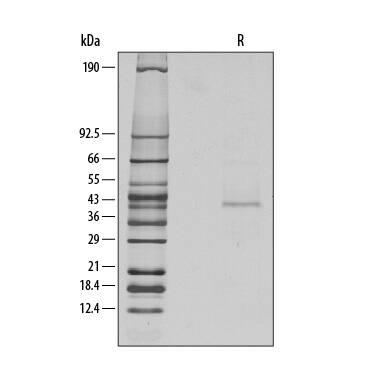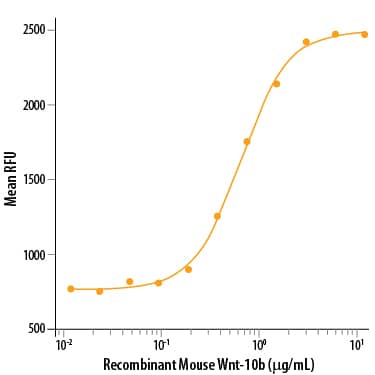Recombinant Mouse Wnt-10b Protein
R&D Systems, part of Bio-Techne | Catalog # 2110-WN

Key Product Details
Product Specifications
Source
Met1-Lys389
Purity
Endotoxin Level
N-terminal Sequence Analysis
Predicted Molecular Mass
SDS-PAGE
Activity
The ED50 for this effect is 0.3-1.2 μg/mL.
Scientific Data Images for Recombinant Mouse Wnt-10b Protein
Recombinant Mouse Wnt-10b Protein Bioactivity
Recombinant Mouse Wnt-10b (Catalog # 2110-WN) stimulates cell proliferation/survival of the IEC-18 rat small intestinal epithelial cell line. The ED50 for this effect is 0.3-1.2 μg/mL.Recombinant Mouse Wnt-10b Protein SDS-PAGE
1 μg/lane of Recombinant Mouse Wnt-10b was resolved with SDS-PAGE under reducing (R) conditions and visualized by silver staining, showing a band at 42 kDa.Formulation, Preparation and Storage
Carrier Free
What does CF mean?CF stands for Carrier Free (CF). We typically add Bovine Serum Albumin (BSA) as a carrier protein to our recombinant proteins. Adding a carrier protein enhances protein stability, increases shelf-life, and allows the recombinant protein to be stored at a more dilute concentration. The carrier free version does not contain BSA.
What formulation is right for me?In general, we advise purchasing the recombinant protein with BSA for use in cell or tissue culture, or as an ELISA standard. In contrast, the carrier free protein is recommended for applications, in which the presence of BSA could interfere.
Carrier: 2110-WN
| Formulation | Lyophilized from a 0.2 μm filtered solution in PBS, NaCl, EDTA and CHAPS with BSA as a carrier protein. |
| Reconstitution | Reconstitute at 100 μg/mL in PBS. |
| Shipping | The product is shipped at ambient temperature. Upon receipt, store it immediately at the temperature recommended below. |
| Stability & Storage | Use a manual defrost freezer and avoid repeated freeze-thaw cycles.
|
Carrier Free: 2110-WN/CF
| Formulation | Lyophilized from a 0.2 μm filtered solution in PBS, NaCl, EDTA and CHAPS. |
| Reconstitution | Reconstitute at 100 μg/mL in PBS. |
| Shipping | The product is shipped at ambient temperature. Upon receipt, store it immediately at the temperature recommended below. |
| Stability & Storage | Use a manual defrost freezer and avoid repeated freeze-thaw cycles.
|
Background: Wnt-10b
Wnt-10b (also known as Wnt-12) is a 42‑44 kDa member of the Wnt family of secreted, highly conserved, cysteine-rich glycoproteins that play important roles in vertebrate pattern formation, cell fate decision, axon guidance, and tumor formation (1‑3). Mouse Wnt-10b cDNA encodes a 361 amino acid (aa) precursor that contains a 28 aa signal sequence plus a 361 aa mature protein that contains two glycosylation sites, three potential phosphorylation sites, and a potential palmitoylation site (3, 4). A short isoform is reported that lacks aa 143‑238 of the precursor (1, 4). Mouse Wnt-10b shares 97‑98% aa identity with human, rat, equine, porcine and canine Wnt-10b. Wnt-10b plays a critical role in maintaining mesenchymal stem cells and determining whether they differentiate to adipocytes or osteoblasts (5‑7). Mouse Wnt-10b deletion produces age‑dependent loss of bone mass due to defective production of osteoblasts, while transgenic over‑expression increases postnatal osteoblast differentiation and inhibits adipocyte differentiation (5‑7). Ectopic expression of Wnt-10b in an obesity and diabetes‑prone background, such as the ob/ob mouse, inhibits obesity (8). In mouse skeletal muscle, Wnt-10b is expressed inversely with SREBP1c and increases insulin sensitivity (9). In humans, a mis‑sense polymorphism is responsible for a malformation of hands and feet, while a C256Y inactivating mutation is associated with severe early-onset obesity (10, 11). Wnt-10 is mainly produced by stem cells and pre-osteoblasts, but also by adult bone marrow CD8+ T lymphocytes stimulated with parathyroid hormone (12). In some hepatocellular carcinomas, Wnt-10b can inhibit cancer cell growth, but in others, it can act synergistically with FGFs to stimulate cell growth (13). Several Wnts, including Wnt-10b, are expressed in both normal and/or malignant colon tissues (14). As a key regulator, Wnt signaling plays a major role in the process of colon carcinogenesis (15).
References
- Wang, J. and G.M. Shackleford (1996) Oncogene 13:1537.
- Katoh, M. (2008) Curr. Drug Targets 9:565.
- Hausmann, G. et al. (2007) Nat. Rev. Mol. Cell Biol. 8:331.
- Swiss Prot Accession # P48614.
- Stevens, J.R. et al. (2010) J. Bone Miner. Res. 25:2138.
- Bennett, C.N. et al. (2007) J. Bone Miner. Res. 22:1924.
- Bennett, C.N. et al. (2005) Proc. Natl. Acad. Sci. USA 102:3324.
- Wright, W.S. et al. (2007) Diabetes 56:295.
- Abiola, M. et al. (2009) PLoS ONE 4:e8509.
- Ugur, S.A. and A. Tolun (2008) Hum. Mol. Genet. 17:2644.
- Christodoulides, C. et al. (2006) Diabetologia 49:678.
- Terauchi, M. et al. (2009) Cell Metab. 10:229.
- Yoshikawa, H. et al. (2007) Mol. Biol. Cell 18:4292.
- Holcombe, R.F. et al. (2002) J. Clin. Pathol: Mol. Pathol. 55:220.
- Cynthia K. et al. (2007) Proc. Natl. Acad. Sci. USA.
Long Name
Alternate Names
Gene Symbol
UniProt
Additional Wnt-10b Products
Product Documents for Recombinant Mouse Wnt-10b Protein
Product Specific Notices for Recombinant Mouse Wnt-10b Protein
For research use only

